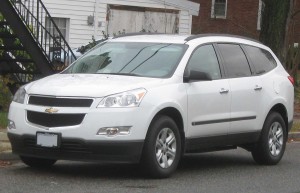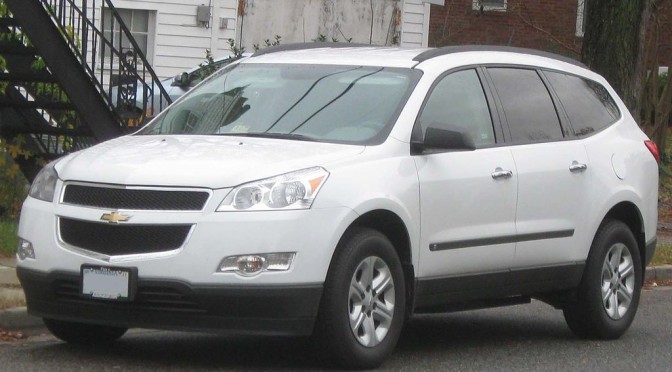The Chevrolet Traverse, or Chevy Traverse, as it’s often known, is one of the General Motors large Lambda SUVs, along with its twins the GMC Acadia, Buick Enclave, and now discontinued Saturn Outlook. Together they form a collection of the most popular large SUVs sold today in the United States. The Traverse competes with other giant SUVs like the Chevrolet Tahoe, GMC Yukon, Toyota Sequoia, and Nissan Armada among families who need–or simply want–something larger than a, say, Honda Pilot or Toyota Highlander, but who aren’t looking to spend as much money as they would in the luxury segment with a Mercedes Benz GL-Class SUV. They’re more bread and butter large SUVs.
I had the pleasure of fitting a range of car seats into the Traverse’s GMC twin, the Acadia, last Memorial Day. However, I ran out of time before I had to return it and still had a number of seats left to test. Fortunately, I borrowed a Traverse this past week and have been putting it through its paces. Being essentially the same vehicle with very slight interior and exterior trim changes, this list features all of the initial 3 across installations I got to work in the Acadia as well as a number of new ones I puzzled together in the Traverse. Before looking at the results, though, it’s worth reviewing which kinds of seats are appropriate for kids at different age ranges.
First of all, I suggest rear-facing from day one until you can’t anymore. Rear-facing is the way to go even if it takes you through the preschool years (ideally until 4!). Once you can’t fit your child in a rear-facing seat anymore, forward-face him or her in harnessed convertible or combination seats (ideally until 8!). Once your children outgrow their harnessed seats, it’s best to keep them restrained in high-back boosters until they’re physically and psychologically ready to use adult seat belt systems (which typically happens between 10 and 12). The overriding goal is safety, which comes from using certain kinds of seats at certain times.
With all that out of the way, here’s what I found in a nutshell: the Traverse is a huge SUV, which means you’re going to get most of your potential installations to work if you’re patient and make use of the strategies I suggest below.
The list isn’t complete, but it’s my goal to make it as complete as possible over time. If you find the list helpful when shopping for car seats, you can shop through my Amazon link below. I’ll add more seats as I test them over time.
You can access the complete 3 across guide for every vehicle here and the complete list of recommended seats here. The Canadian car seat guide is here. 3 across car seat images here are courtesy of Wikipedia.
 2007, 2008, 2009, 2010, 2011, 2012, 2013, 2014, 2015 Chevrolet Traverse
2007, 2008, 2009, 2010, 2011, 2012, 2013, 2014, 2015 Chevrolet Traverse
Guaranteed 3 across installations:
Clek Fllo (x3).
Clek Foonf (x3).
Britax Boulevard ClickTight, Diono Radian / RXT, Britax Frontier G1.1.
Britax Boulevard G4.1, Diono Radian / RXT, Britax Frontier G1.1.
Britax Marathon ClickTight, Diono Radian / RXT, Britax Frontier G1.1.
Britax Marathon G4.1, Diono Radian / RXT, Britax Frontier G1.1.
Britax Boulevard ClickTight, Diono Radian / RXT, Britax Frontier G1.1.
Britax Pavilion G4, Diono Radian / RXT, Britax Frontier G1.1.
Diono Radian / RXT, Chicco KeyFit 30, Graco TurboBooster.
Diono Radian / RXT, Diono Radian / RXT, Graco TurboBooster.
Britax Boulevard ClickTight, Clek Fllo, Britax Frontier G1.1.
Britax Boulevard G4.1, Clek Fllo, Britax Frontier G1.1.
Britax Marathon ClickTight, Clek Fllo, Britax Frontier G1.1.
Britax Marathon G4.1, Clek Fllo, Britax Frontier G1.1.
Britax Boulevard ClickTight, Clek Fllo, Britax Frontier G1.1.
Britax Pavilion G4, Clek Fllo, Britax Frontier G1.1.
Tips and Tricks:
The current and only generation of the Chevrolet Traverse is 201 inches long and 78 inches wide, which means you’re going to be able to fit most seats you can think of in 3 across installations with enough effort and a bit of planning. However, there are a few things to be aware of that can make the job significantly easier or more difficult, depending on how you approach them.
First of all, if you have a 3 across setup in the 2nd row, it’s going to be very difficult for anyone to access the 3rd row. You might want to install only a pair of seats in the 2nd row and then another 2 or 3 in the 3rd row if you need to install or use more than 3 car seats on a regular basis.
Second, the biggest challenge in 3 across setups in the 2nd row will be fitting a pair of seats on the driver and center vehicle seats, as there’s a 60/40 split to deal with. Once you overcome that, just about any car seat will fit on the passenger end.
Third, there’s only one top tether anchor available in the 3rd row for forward-facing seats, which means that you won’t want to have more than one forward-facing seat at a time in the 3rd row if at all possible (see here for why tethering forward-facing seats is essential).
Remember, as always, to use seat belt installations instead of LATCH to maximize available space.
—
If you find the information on car safety, recommended car seats, and car seat reviews on this car seat blog helpful, you can shop through this Amazon link for any purchases, car seat-related or not. Canadians can shop through this link for Canadian purchases.


